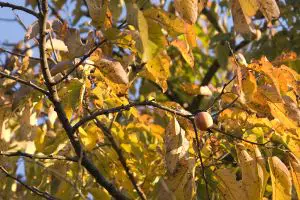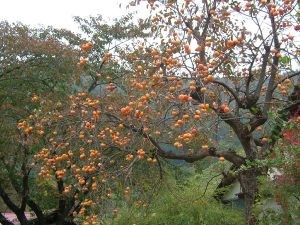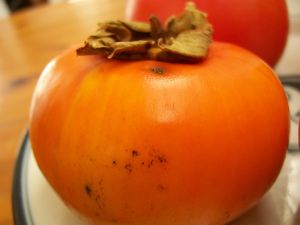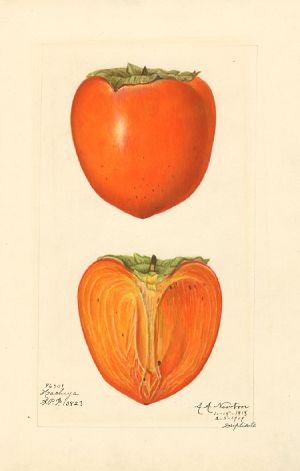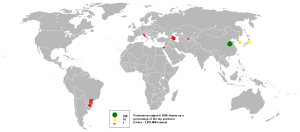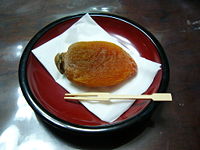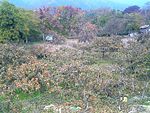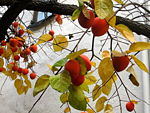Difference between revisions of "Persimmon" - New World Encyclopedia
Rick Swarts (talk | contribs) (added article from Wikipedia and credit/category tags) |
Rick Swarts (talk | contribs) |
||
| Line 1: | Line 1: | ||
| − | |||
{{Taxobox | {{Taxobox | ||
| name = Persimmon | | name = Persimmon | ||
| Line 14: | Line 13: | ||
| subdivision = See text | | subdivision = See text | ||
}} | }} | ||
| + | '''Persimmon''' is the common name for several tropical and subtropical trees and shrubs in the genus ''Diospyros'', characterized by alternate [[leaf|leaves]], hard wood, and fleshy, globular [[fruit]]s. Two well known persimmons are the Japanese persimmon (''D. kaki'') and the common persimmon or eastern persimmon (''D. virginiana''). The name persimmon also is used for the edible [[fruit]] of these trees, which is a popular commercial fruit. the | ||
| − | + | collective term for the entire genus, although also known as the | |
| + | persimmon | ||
| + | |||
| + | |||
| + | edible [[fruit]] of a number of species of trees of the genus ''[[Diospyros]]'' in the ebony wood family ([[Ebenaceae]]). The word ''persimmon'' is derived from ''putchamin'', ''pasiminan'', or ''pessamin'', from [[Powhatan]], an [[Algonquian languages|Algonquian language]] (related to [[Blackfoot language|Blackfoot]], [[Cree language|Cree]] and [[Mohican language|Mohican]]) of the [[eastern United States]], meaning "a dry fruit".<ref> Mish, Frederic C., Editor in Chief ''Webster's Ninth New Collegiate Dictionary'' Springfield, Massachuetts, U.S.A.:1984—Merriam-Webster Page 877</ref> Persimmons are generally light [[Gold (color)|yellow-orange]] to dark [[red-orange]] in color, and depending on the species, vary in size from 1.5-9 cm (0.5-4 in) diameter, and may be spherical, acorn-, or pumpkin-shaped.<ref>{{cite web | ||
|url = http://www.extento.hawaii.edu/kbase/crop/crops/i_persim.htm | |url = http://www.extento.hawaii.edu/kbase/crop/crops/i_persim.htm | ||
|title = General Crop Information: Persimmon | |title = General Crop Information: Persimmon | ||
Revision as of 21:19, 5 August 2008
| Persimmon | ||||||||||||
|---|---|---|---|---|---|---|---|---|---|---|---|---|
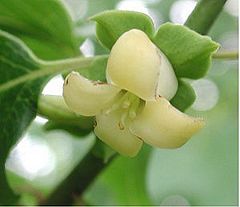 American persimmon flower
| ||||||||||||
| Scientific classification | ||||||||||||
| ||||||||||||
|
See text |
Persimmon is the common name for several tropical and subtropical trees and shrubs in the genus Diospyros, characterized by alternate leaves, hard wood, and fleshy, globular fruits. Two well known persimmons are the Japanese persimmon (D. kaki) and the common persimmon or eastern persimmon (D. virginiana). The name persimmon also is used for the edible fruit of these trees, which is a popular commercial fruit. the
collective term for the entire genus, although also known as the persimmon
edible fruit of a number of species of trees of the genus Diospyros in the ebony wood family (Ebenaceae). The word persimmon is derived from putchamin, pasiminan, or pessamin, from Powhatan, an Algonquian language (related to Blackfoot, Cree and Mohican) of the eastern United States, meaning "a dry fruit".[1] Persimmons are generally light yellow-orange to dark red-orange in color, and depending on the species, vary in size from 1.5-9 cm (0.5-4 in) diameter, and may be spherical, acorn-, or pumpkin-shaped.[2] The calyx often remains attached to the fruit after harvesting, but becomes easier to remove as it ripens. They are high in glucose, with a balanced protein profile, and possess various medicinal and chemical uses.
Species
The most widely cultivated species is the Japanese kaki persimmon or kaki (柿 kaki) (Diospyros kaki), called "shizi" (柿子) in Chinese. These are sweet, slightly tart fruits with a soft to occasionally fibrous texture. This species, native to China, is deciduous, with broad, stiff leaves. Cultivation of the fruit extended first to other parts of east Asia, and was later introduced to California and southern Europe in the 1800s, and numerous cultivars have been selected. It is edible in its crisp firm state, but has its best flavor when allowed to rest and soften slightly after harvest. The Japanese cultivar 'Hachiya' is a widely grown cultivar. The fruit has a high tannin content which makes the immature fruit astringent and bitter. The tannin levels are reduced as the fruit matures. Persimmons like 'Hachiya' must be completely ripened before consumption. When ripe, this fruit comprises thick pulpy jelly encased in a waxy thin skinned shell. "Sharon Fruit" (named originally after Sharon plain in Israel) is the trade name for D. kaki fruit that has been artificially ripened with chemicals.[3] It is also known as the "Korean Mango".
The American persimmon (Diospyros virginiana) is native to the eastern United States.
The Black persimmon or Black sapote (Diospyros digyna) is native to Mexico. Its fruit has green skin and white flesh, which turns black when ripe.
The Mabolo or Velvet-apple (Diospyros discolor) is native to the Philippines. It is bright red when ripe.
The Date-plum (Diospyros lotus) is native to southwest Asia and southeast Europe. It was known to the ancient Greeks as "the fruit of the Gods", i.e. Dios pyros (lit. "the wheat of Zeus"), hence the scientific name of the genus. Its English name probably derives from Persian Khormaloo خرمالو literally "Date-Plum", referring to the taste of this fruit which is a reminiscent of both plums and dates. This species is one candidate for the lotus mentioned in the Odyssey: it was so delicious that those who ate it forgot about returning home and wanted to stay and eat lotus with the lotus-eaters.[4]
There are many other species of persimmon that are inedible to humans, and thus have little or no commercial value for their fruit.
Fruit
Commercially, there are generally two types of persimmon fruit: astringent and non-astringent.
The heart-shaped Hachiya is the most common variety of astringent persimmon. Astringent persimmons contain very high levels of soluble tannins and are unpalatable if eaten before softening. The astringency of tannins is removed through ripening by exposure to light over several days, or artificially with chemicals such as alcohol and carbon dioxide which change tannin into the insoluble form. This bletting process is sometimes jumpstarted by exposing the fruit to cold or frost which hastens cellular wall breakdown. These astringent persimmons can also be prepared for commercial purposes by drying.
The non-astringent persimmon is squat like a tomato and is most commonly sold as fuyu. Non-astringent persimmons are not actually free of tannins as the term suggests, but rather are far less astringent before ripening, and lose more of their tannic quality sooner. Non-astringent persimmons may be consumed when still very firm to very very soft.
There is a third type, less commonly available, the pollination-variant non-astringent persimmons. When fully pollinated, the flesh of these fruit is brown inside -known as goma in Japan, and the fruit can be eaten firm. These varieties are highly sought after and can be found at specialty markets or farmers markets only. Tsurunoko, sold as "Chocolate persimmon" for its dark brown flesh, Maru, sold as "Cinnamon persimmon" for its spicy flavor, and Hyakume, sold as "Brown sugar" are the three best known.
| Persimmons Nutritional value per 100 g | |||||||||||||||||||||
|---|---|---|---|---|---|---|---|---|---|---|---|---|---|---|---|---|---|---|---|---|---|
| Energy 70 kcal 290 kJ | |||||||||||||||||||||
| |||||||||||||||||||||
Diospyros kaki, raw Percentages are relative to US recommendations for adults. Source: USDA Nutrient database | |||||||||||||||||||||
Culinary uses
Persimmons are eaten fresh or dried, raw or cooked. When eaten fresh the peel is usually cut/peeled off and the fruit is often cut into quarters or eaten whole like an apple. The flesh ranges from firm to mushy and the texture is unique. The flesh is very sweet and when firm possesses an apple-like crunch. In China, Korea, Japan, and Vietnam after harvesting, 'Hachiya' persimmons are prepared using traditional hand-drying techniques, outdoors for two to three weeks. The fruit is then further dried by exposure to heat over several days before being shipped to market. In Japan the dried fruit is called hoshigaki (干し柿), In China it is known as "shi-bing" (柿饼)in Korea it is known as gotgam (hangul: 곶감), and in Vietnam it is called hồng khô. It is eaten as a snack or dessert and used for other culinary purposes. In Korea, dried persimmon fruits are used to make the traditional Korean spicy punch, sujeonggwa, while the matured, fermented fruit is used to make a persimmon vinegar called gamsik cho (감식초), which is believed to have a wide variety of holistic properties. The hoshigaki tradition traveled to California with Japanese American immigrants. A few farms still practice the art, which is being revived in part through the efforts of Slow Food USA, which describes the technique on its site and provides links to producers. [5] [6] In some areas of Manchuria and Korea, the dried leaves of the fruit are used for making tea. The Korean name for this tea is ghamnip cha (감잎차).
The persimmon also figures prominently in American culinary tradition. It can be used in cookies, cakes, puddings, salads and as a topping for breakfast cereal. Persimmon pudding is a dessert using fresh persimmons. An annual persimmon festival, featuring a persimmon pudding contest, is held every September in Mitchell, Indiana. Persimmon pudding is a baked pudding that has the consistency of pumpkin pie but resembles a brownie and is almost always topped with whipped cream. Persimmons may be stored at room temperature (20°C) where they will continue to ripen. It is also a native plant in Brazil, South America, where it is referred to as the Caqui.
Ethnomedical uses
- In traditional Chinese medicine the fruit regulates ch'i
- The raw fruit is used to treat constipation and hemorrhoids, and to stop bleeding. As such, it is not a good idea to consume too many persimmons at once- they can induce diarrhea.
- The cooked fruit is used to treat diarrhea and dysentery
Phytonutrients
The fruits of some persimmon varieties contain the tannins catechin and gallocatechin,[7] as well as the anti-tumor compounds betulinic acid and shibuol, although the latter may also cause gastrointestinal problems.
Medical precaution
Unripened persimmons contain the soluble tannin shibuol, which, upon contact with a weak acid, polymerizes in the stomach and forms a gluey coagulum that can affix with other stomach matter.[8] The Merck Manual of Diagnosis and Therapy notes that consumption of persimmons has been known to cause bezoars that require surgery in over 90% of cases. Persimmon bezoars often occur in epidemics in regions where the fruit is grown.[9][10] Horses may develop a taste for the fruit growing on a tree in their pasture and overindulge also, making them quite ill. It is often advised that persimmons should not be eaten with crab meat[11][12][13], nor should they be eaten on an empty stomach.
Wood
Though persimmon trees belong to the same genus as ebony trees, persimmon tree wood has a limited use in the manufacture of objects requiring hard wood. Persimmon wood is used for paneling in traditional Korean and Japanese furniture.
In North America, the lightly colored, fine-grained wood of D. virginiana is used to manufacture billiard cues and shuttles (used in the textile industry). Persimmon wood was also heavily used in making the highest-quality heads of the golf clubs known as "woods," until the golf industry moved primarily to metal woods in the last years of the 20th century. Persimmon woods are still made, but in far lower numbers than in past decades. Over the last few decades persimmon wood has become popular among bow craftsmen, especially in the making of traditional longbows.
Like some other plants of the genus Diospyros, older persimmon heartwood is black or dark brown in color, in stark contrast to the sapwood and younger heartwood, which is pale in color.
Gallery
ReferencesISBN links support NWE through referral fees
- ↑ Mish, Frederic C., Editor in Chief Webster's Ninth New Collegiate Dictionary Springfield, Massachuetts, U.S.A.:1984—Merriam-Webster Page 877
- ↑ General Crop Information: Persimmon. University of Hawaii, Extension Entomology & UH-CTAHR Integrated Pest Management Program. Retrieved 2007-01-15.
- ↑ Persimmon Fruit Facts. California Rare Fruit Growers, Inc.,. Retrieved 2007-01-15.
- ↑ The Odyssey by Homer, p.76 of this public domain e-text. Project Gutenberg. Retrieved 2007-10-13.
- ↑ Slow Food USA
- ↑ Food for Health, Produces Most Honestly [sic]. Korea Agro-Fisheries Trade Corp.. Retrieved 2007-01-15.
- ↑ SpringerLink WoodScience
- ↑ Verstanding AG, Bauch K, Bloom R, Hadas I, Libson E; Small-bowel phytobezoars: detection with radiography, Radiology, 1989;172:705-707
- ↑ The Merck Manuals Online Medical Libraries, Section: Gastrointestinal Disorders, Subject: Bezoars and Foreign Bodies, Topic: Bezoars
- ↑ Merck Manual, Rahway, New Jersey, Sixteenth Edition, Gastrointestinal Disorders, Section 52, page 780
- ↑ http://www.zagalchi.co.kr/zagal/eza-sangsik1.php
- ↑ http://www.eatingchinese.org/dazha/dazha1.htm
- ↑ http://www.newsgd.com/enjoylife/living/dining/200409070006.htm
External links
- University of Florida: Oriental Persimmons in Florida, USA
- 2008 Mitchell Persimmon Festival, Mitchell, Indiana USA
- persimmonpudding.com - dedicated to growing, education, and use of Diospyros virginiana L., the common, or American persimmon
- (Japanese) カキに関する情報提供システム (Information about kaki persimmons), National Institute of Fruit Tree Science, Japan
- "Family Tree" Article about persimmon farm on Maui, HI by Matt Thayer. Maui No Ka 'Oi Magazine Vol.11 No. 6 (Nov. 2007).
Credits
New World Encyclopedia writers and editors rewrote and completed the Wikipedia article in accordance with New World Encyclopedia standards. This article abides by terms of the Creative Commons CC-by-sa 3.0 License (CC-by-sa), which may be used and disseminated with proper attribution. Credit is due under the terms of this license that can reference both the New World Encyclopedia contributors and the selfless volunteer contributors of the Wikimedia Foundation. To cite this article click here for a list of acceptable citing formats.The history of earlier contributions by wikipedians is accessible to researchers here:
The history of this article since it was imported to New World Encyclopedia:
Note: Some restrictions may apply to use of individual images which are separately licensed.
